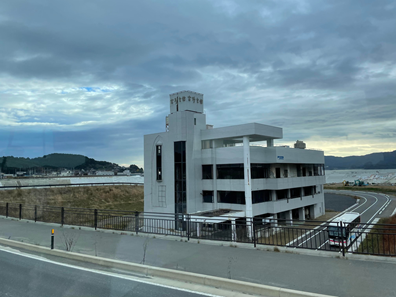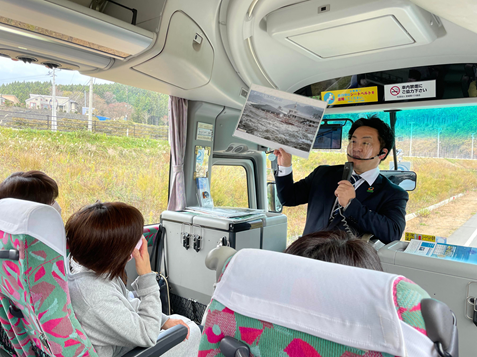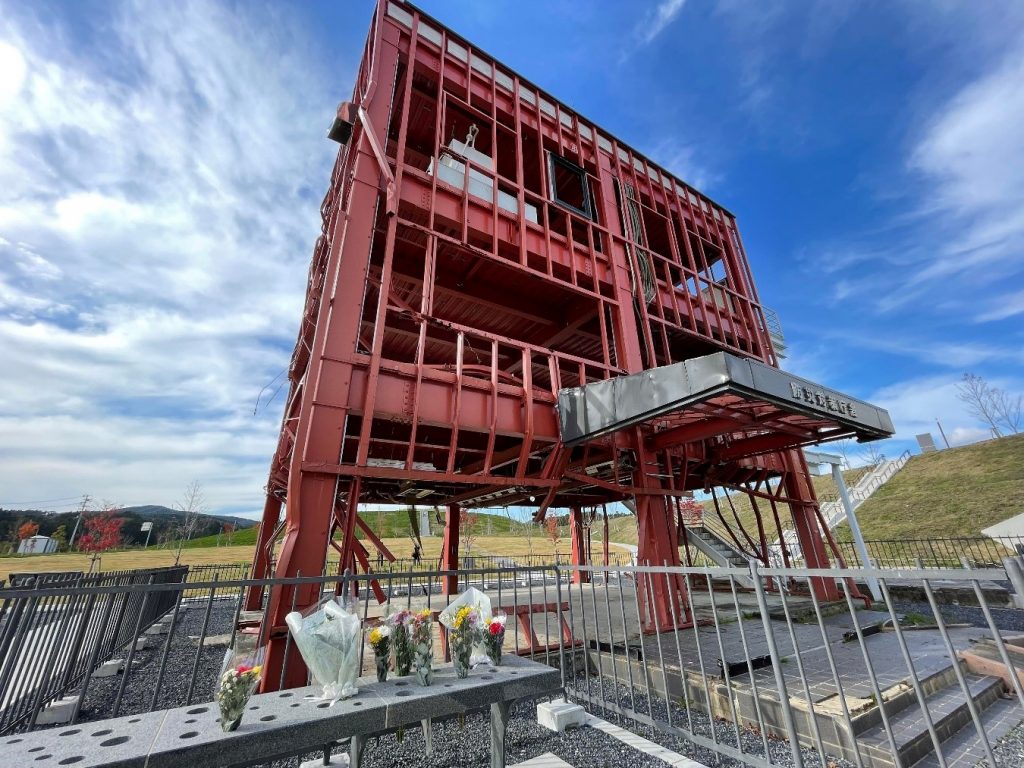by Julia Gerster
As every morning, a large bus travels the almost empty streets of Minamisanriku. Every now and then it stops in front of a damaged, empty building. Sometimes the building is still intact but abandoned. Sometimes only the skeleton of a building is left. The passengers listen in silence to their guide, while they take pictures of the scenery in this town where more than 3000 houses were destroyed and over 800 people lost their lives.
This bus and many more are part of a post-disaster tourism program in Minamisanriku, one of the coastal municipalities that was heavily hit by the 2011 Great East Japan Earthquake and tsunami. Every morning they take their passengers on a tour through the city to keep alive the memory of a community in danger of being forgotten. While population decline was already a problem before 2011, the disaster only accelerated the dwindling of the region’s citizens. Besides its educational purpose, post-disaster tourism in Minamisanriku was therefore introduced to raise the so-called “related population” (kōryu jinkō), a term that describes people who have connections to the region without living there. Building on previous revitalization programs (Ivy, 1995; Robertson, 1988), some of which are described in this blog, tourists are not only expected to generate income in the disaster-affected areas and turn Tohoku into a hub for disaster education, but also to economically support the recovering regions. By 2016, several campaigns supported by the national Reconstruction Agency in fact raised visitor numbers, even surpassing those of pre-2011, to areas of the Tohoku region that previously only received about 1 percent of the international tourists to Japan (Reconstruction Agency, 2021).

Copyright © Julia Gerster 2021
However, several challenges remain regarding disaster tourism. During my ongoing field research about cultural and collective memory of the 3.11 disasters, many local residents shared their concerns about tourism initiatives. Those concerns refer to visitors joining tours through devastated communities and taking pictures of places where friends and family lost their lives. They point to an ongoing debate about visits to places connected to death and disaster, also known as “dark tourism” (Foley and Lennon, 1996; Ide, 2018; Martini and Buda, 2018). Many tourism scholars have stressed ethical concerns regarding dark tourism, including early visits to disaster-stricken places. Consequences could be tourists hampering rescue or recovery efforts, voyeurism and inappropriate behavior of non-locals, such as littering or entering dangerous places or private property (Bornemann, 2018; Rolfes, 2010), as the controversial “Fukushima” episode of the Netflix series “Dark Tourist” showed (Ryall, 2018). One of the most debated aspects of dark tourism is the negative image of tour organizers and participants at places that experienced tragedies. “Some people blamed me for marketizing the disaster,” told Shun Ito, who survived the 2011 tsunami and today guides guests of the local Hotel Kanyo on bus tours through the still recovering Minamisanriku. “Can you imagine how hard it is to be told something like this by friends? But I still believe that we must keep talking about this disaster as to not repeat such tragedies again.”

Copyright © Julia Gerster 2021
Yet, the constant risk of natural hazards that Japan faces underlines the educational merits of post-disaster tourism. At the end of his tour, Ito would always explain to visitors: “I want you to remember the distance between the shore and the evacuation centers, and the markers that show the run-up heights of the tsunami. It is because you came here and experienced how long it would take to evacuate to the rooftop or to the mountains that you understand the difficulties of making fast decisions during an emergency situation. It is easy to read about a tsunami of 17 meters height, but you hopefully won’t forget the feeling standing next to a building showing the damage of the tsunami. I want you to remember these impressions so that they will be useful for being better prepared when another disaster occurs.”
Noriko Abe, the owner of Minamisanriku’s Hotel Kanyo further stresses the economic meaning of the hotel industry for the region. “If we stay in business, there will be jobs for butchers, farmers, tea merchants… The fewer people continue to live here, the more important it is to have visitors who support the residents.”

Copyright © Julia Gerster 2021
However, the COVID-19 pandemic proved once more the problems connected to what Littlejohn (2020) calls a museumification of Tohoku and a tourism centered reconstruction. Due to the threat of future tsunamis, residential reconstruction is not allowed in the former town center of Minamisanriku. Instead, the San San Shotengai, a shopping area featuring local products and delicacies, was constructed. It stands on top of several meters of artificially raised land right next to the ruins of the disaster management headquarters (bōsai taisaku chōsha) where 43 people died in the tsunami. Disconnected from the residential neighborhood and isolated because of requests to avoid travelling during the COVID-19 pandemic, this shopping area remained mostly empty from 2020 to 2021. The hopes of Noriko Abe and her staff now rely on plans of the government to restart the so called “Go To travel” campaign that yet again tries to use tourism as a recovery method – this time recovery from financial damage caused by the pandemic. Meanwhile the challenges of negotiating post-disaster tourism, concerns of residents, revitalization and disaster education are likely to continue.
References
Bornmann, N. (2018). The ethics of teaching at sites of violence and trauma. Student Encounters with the Holocaust. Palgrave Pivot. New York.
Foley, M. & Lennon, J.J (1996). Editorial: Heart of darkness. International Journal of Heritage Studies, 2(4), pp. 195-197.
Ide, A. (2018). Dark Tourism. Travel related to sad memories. Tokyo, Gentosha. (In Japanese).
Ivy, M. (1995). Discourses of the Vanishing: Modernity, Phantasm, Japan, Chicago: University of Chicago Press.
Littlejohn, A. (2020). Museums of themselves: disaster, heritage, and disaster heritage in Tohoku, Japan Forum, https://doi.org/10.1080/09555803.2020.1758751
Martini, A. and Buda, D. (2018): Dark tourism and affect: framing places of death and disaster. Current Issues in Tourism, 1-14.
Reconstruction Agency (2021). The Process and Prospects for Reconstruction. https://www.reconstruction.go.jp/english/topics/Progress_to_date/index.html
Robertson, J. (1988) Furusato Japan: The Culture and Politics and Nostalgia. International Journal of Politics, Culture, and Society International Journal of Politics, Culture, and Society, 1 (4), pp. 494-518.
Rolfes, M (2010). Poverty tourism: Theoretical reflections and empirical findings on an extraordinary form of tourism. GeoJournal, 75(5), pp. 421-442.
Ryall, J. (2018), Fukushima episode of Netflix’s Dark Tourist sparks offence in Japan South China Morning Post:https://sg.news.yahoo.com/fukushima-episode-netflix-dark-tourist-092531516.html 5.September.2018
Julia Gerster received her PhD in Japanese studies from the Graduate School of East Asian Studies, FU Berlin. She currently works as assistant professor at the International Research Institute of Disaster Science at Tohoku University. Her research interests include the collective and cultural memory of disasters, the role of local culture in disaster recovery, and post-disaster social relations.
